Barbary Lion

Extinct in wild 1950
The Barbary lion was considered one of the biggest lion subspecies. They had dark, long-haired manes that extended over the shoulder and down to the belly. It is said that they developed the colors and size of their manes due to ambient temperatures, their nutrition, and their level of testosterone. It is also possible that they developed such long manes due to the temperature in the Atlas Mountains, which is much lower than other regions in Africa.
Habitat
The Barbary lions inhabited the range countries of the Atlas Mountains, including the Barbary coast. Some of these areas included Morocco, Algeria, and Maghreb. The Atlas Mountains had cold temperatures when compared to other parts of the African region, especially in the winter. The Barbary lions lived in prides, even when there were not many of them left, especially in the eastern Maghreb.
Extinction
The Barbary lions are considered extinct in the wild and most likely in captivity as well. The last known wild Barbary lion was shot in the Moroccan part of the Atlas Mountains in 1942. However, several people reported sightings of the Barbary lions in the 1950's in Morocco and Algeria although it was never proven. Some people say that small populations may have even survived until the early 1960's, but it is not known for sure. These lions used to be offered to royal families of Morocco and Ethiopia and were known as the "royal" lions. It is said that some of these "royal" lions survived until the late 1960's, until a respiratory disease just about wiped them all out. There are a handful of the "royal" lions today that may be considered mostly pure Barbary descendents, although it has not been proven. There are a handful of lions in European zoo's that are considered partly descendents of the Barbary lion, but not full blood Barbary lions. There have been numerous sighting over the past three decades, but none of them have been genetically proven. The IUCN considers the Barbary lion extinct in the wild and in captivity.